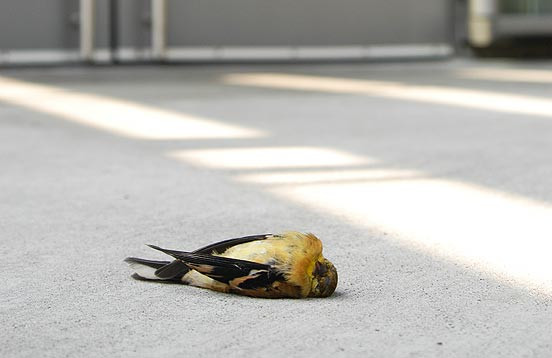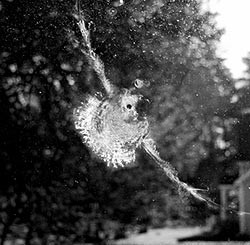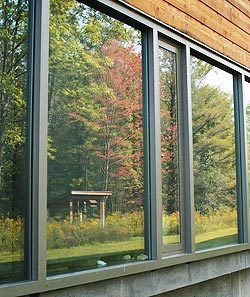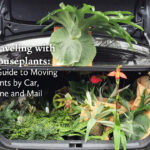Bird collisions with windows are a widespread and devastating problem. Often, windows become invisible barriers to birds, reflecting sky or vegetation, leading them into a deadly trap. The sheer number of windows in our homes and buildings contributes to an alarming statistic: up to one billion birds die annually in the U.S. due to window strikes, according to a 2014 study. This tragic reality emphasizes the urgent need for effective solutions to mitigate this threat.
Fortunately, making your windows bird-safe is achievable with straightforward and practical measures. Experts like Christine Sheppard, director of the Bird Collisions Program at the American Bird Conservancy, emphasize that simple remedies can significantly reduce the danger windows pose to birds. Organizations like the American Bird Conservancy and the Fatal Light Awareness Program (FLAP) offer comprehensive resources and guidance on preventing these collisions.
 american goldfinch killed by window strike
american goldfinch killed by window strike
A deceased American Goldfinch, victim of a window strike, highlighting the serious threat windows pose to birdlife.
The impact of window collisions on birds is often fatal. Even if a bird appears to recover and fly away after hitting a window, it frequently succumbs to internal injuries, such as brain hemorrhaging or bruising, later on. Daniel Klem, a researcher at Muhlenberg College who has studied this issue for decades, poignantly describes glass as “an indiscriminate killer,” affecting both strong and weak birds alike. This underscores the indiscriminate nature of window collisions and the broad impact on bird populations.
Understanding Why Birds Fly Into Windows
 imprint of dove on plate glass window
imprint of dove on plate glass window
A window imprint left by a Mourning Dove, demonstrating the force and impact of bird-window collisions.
Bird collisions can be categorized into two primary types: daytime and nighttime collisions, each with distinct causes.
During the day, birds collide with windows primarily because of reflections. Windows mirror the surrounding environment, particularly vegetation and sky, creating an illusion of open passage. Birds perceive these reflections as real landscapes and attempt to fly through them, leading to collisions. Furthermore, birds may see through windows to indoor plants or vegetation on the opposite side of a building, further contributing to daytime strikes.
At night, the danger shifts for nocturnal migrating birds, which include a vast majority of songbirds. These birds are disoriented by artificial lights. City lights and brightly lit windows attract and confuse them, especially during foggy or low-ceiling conditions. The reasons are not fully understood, but light pollution diverts them from their natural migratory paths. Drawn to illuminated areas, they become trapped, milling about and frequently colliding with lighted structures and windows. This nocturnal disorientation can have cascading effects. Birds attracted to urban lights may find temporary roosting places, only to face the daytime hazard of reflective windows the following day. Projects like BirdCast and FLAP are dedicated to studying and mitigating the problem of light pollution on migratory birds.
Another, less common, reason for window strikes is territorial aggression. Particularly during spring breeding season, birds may see their reflection in a window and perceive it as a rival. This triggers aggressive behavior, causing them to repeatedly attack their reflection. While this behavior can be bothersome for homeowners, it rarely results in fatal injuries for the bird and often ceases after the breeding season. Many of the solutions recommended for general window strike prevention are also effective in deterring territorial attacks.
Effective Strategies to Protect Birds From Window Collisions
 reflection of foliage in window – hazard to birds
reflection of foliage in window – hazard to birds
A window reflecting trees and sky, illustrating how natural reflections become hazards for birds.
The first step in making your home bird-safe is to identify potential danger zones. Focus on large windows, picture windows, corner windows (paired at right angles), and windows located near bird feeders or natural vegetation. To assess the risk, step outside and observe your windows from a bird’s perspective. If you see reflections of trees, bushes, or sky, or if you can see through to vegetation on the other side, these windows pose a collision risk. Contrary to older beliefs, the distance of bird feeders from windows is less critical than making the windows themselves bird-friendly. If you have feeders near windows, prioritize treating the windows to prevent strikes.
Practical Treatments for Existing Windows
For smaller birds, applying markings to windows is crucial. Decals, patterns, or other deterrents should be spaced no more than 2 inches apart to be effective against even the smallest birds like hummingbirds and kinglets. Acopian BirdSavers, utilizing paracord, can be spaced slightly wider at 4 inches due to their enhanced visibility. Crucially, all treatments must be applied to the exterior surface of the window.
-
Temporary Solutions: Tempera Paint or Soap. For a budget-friendly and temporary fix, use tempera paint or soap to mark the outside of your windows. Create a grid pattern with 2-inch squares, or explore your artistic side with window paintings. Tempera paint is durable yet easily removable when needed.
-
Decals, Stickers, and Films. Apply decals, stickers, sun catchers, mylar strips, or even masking tape to the exterior glass. Remember, density is key – sparsely placed stickers are ineffective. Hawk silhouettes are largely ineffective as general bird deterrents. Ensure markings are closely spaced to cover most of the glass surface, preventing birds from attempting to fly through gaps.
-
Dot Patterns and Specialized Tapes. Long-lasting tapes with pre-spaced dot patterns offer a convenient and effective solution. Products from companies like Feather Friendly provide correctly spaced dots that are proven to deter bird collisions. These specialized tapes are designed for durability and ease of application.
-
Acopian BirdSavers (Zen Curtains). These “zen curtains” consist of closely spaced cords hanging vertically down the window. They function similarly to tapes or decals by creating a visual barrier but are often considered more aesthetically pleasing and easier to install. Acopian BirdSavers are highly effective and are used at the Cornell Lab of Ornithology’s headquarters to protect birds. You can purchase pre-made BirdSavers or create your own using readily available materials.
-
External Screens. Installing mosquito screens over your windows is a highly effective method, provided they are mounted on the outside and fully cover the window surface. Screens create a visual and physical barrier that prevents birds from reaching the glass.
-
Netting Barriers. Cover windows with netting on the outside, positioned at least 3 inches away from the glass. The netting should be taut enough to gently deflect birds upon contact. Small mesh netting (around 5/8 inch or 1.6 cm) is ideal to prevent entanglement while ensuring effective deflection. Netting can be mounted on frames for easy installation and removal, similar to storm windows.
-
One-Way Transparent Films. Specialized window films, like Collidescape, offer a one-way transparency effect. From the inside, you maintain your view, while from the outside, the window appears opaque to birds. These films can also reduce incoming light and potentially lower cooling costs.
Incorporating Bird-Safe Design in New Homes and Remodels
When building a new home or replacing windows, consider incorporating bird-friendly design elements from the outset:
-
External Shutters. Install external shutters and utilize them strategically. Closing shutters when rooms are unoccupied or when natural light and views are not needed can significantly reduce window strike risks. Shutters also offer energy-saving benefits.
-
External Shades and Awnings. Install external sunshades or awnings to minimize sunlight reflection from windows. Remote-controlled options offer convenience. Awnings and shades reduce reflectivity and can contribute to energy efficiency.
-
Integrated External Screens. For new construction or window replacements, opt for windows designed with integrated external screens that cover the entire outer glass surface.
-
Interior Vertical Blinds. Install interior vertical blinds and keep the slats partially closed. Angled blinds can disrupt reflections and reduce the illusion of open space.
-
Minimize Visual Pathways to Greenery and Sky. Avoid creating direct visual paths through your house to outdoor vegetation or sky. For example, bright windows directly opposite a picture window can create an illusion of a clear flight path. Strategically closing interior doors or using window shades can break these visual pathways.
Lights Out Initiatives
“Lights Out” programs are gaining momentum in cities across the U.S., including major urban centers like New York City, Dallas, and Philadelphia. These initiatives address the problem of light pollution, particularly from office buildings and streetlights, which disorients migrating birds. Reducing non-essential lighting, especially during migration seasons, and utilizing downward-facing lighting fixtures are crucial steps. While these city-wide efforts are vital, homeowners should also implement window strike prevention measures at their residences.
Providing Aid to a Bird Injured by Window Collision
If you find a bird that has collided with a window, immediate action is crucial for its recovery. Even seemingly unharmed birds may have internal injuries that require attention. They are also vulnerable to predators while stunned or injured.
Here’s how to help a window collision victim:
-
Capture and Contain Gently. Approach the bird from behind and carefully cup it with both hands. Expect some fluttering or vocalization. Handle small birds gently, ensuring your grip is secure but not tight.
-
Prepare a Safe Container. Find an unwaxed paper bag or a small cardboard box. Line it with tissue paper or paper towels to provide secure footing. Place the bird in the container and close it securely. Keep the container in a dark, quiet, and warm location, away from children and pets.
-
Do Not Offer Food or Water. Avoid handling, feeding, or watering the bird while it is in the container. Wild birds perceive humans as threats, and unnecessary handling can increase their stress.
-
Locate a Wildlife Rehabilitator. Use online directories (like the Humane Society’s resource) to find a licensed wildlife rehabilitator near you. Contact them for guidance and instructions. If you cannot transport the bird yourself, inform the rehabilitation facility, as they may have transport options.
-
Release Instructions (If Advised). If the rehabilitator instructs you to release the bird, take it to a wooded area or appropriate habitat, away from buildings. Before releasing, observe its flight ability by opening the container in the direction of vegetation while keeping a distance. If the bird’s flight seems weak or unstable, recapture it and contact the rehabilitation facility for further advice.
By implementing these strategies, you can make a significant difference in protecting birds from the dangers of window collisions and contribute to bird conservation efforts in your community.
